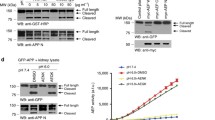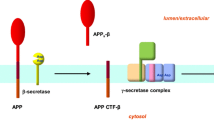Abstract.
Alzheimer’s disease (AD) is characterized by an accumulation in the brain of amyloid β peptides (Aβ). The production of Aβ requires two sequential cleavages induced by β- and γ-secretases on the β-amyloid precursor protein (APP). Altered activity of these secretases is involved in the pathogenesis of AD. The expression and activity of β-secretase (BACE1) is augmented in the brain in late-onset sporadic AD. Mutant presenilin 1 (PS1), the major genetic defect of early-onset familial AD (FAD), alters the activity of γ-secretase, leading to increased production of Aβ42. Here we review the role of oxidative stress as a molecular link between the β- and the γ-secretase activities, and provide a mechanistic explanation of the pathogenesis of sporadic late-onset AD. We also discuss evidence for a role of the same mechanism in the pathogenesis of familial AD carrying PS1 mutations.
Similar content being viewed by others
Author information
Authors and Affiliations
Corresponding author
Rights and permissions
About this article
Cite this article
Tabaton, M., Tamagno, E. The molecular link between β- and γ-secretase activity on the amyloid β precursor protein. Cell. Mol. Life Sci. 64, 2211–2218 (2007). https://doi.org/10.1007/s00018-007-7219-3
Published:
Issue Date:
DOI: https://doi.org/10.1007/s00018-007-7219-3




